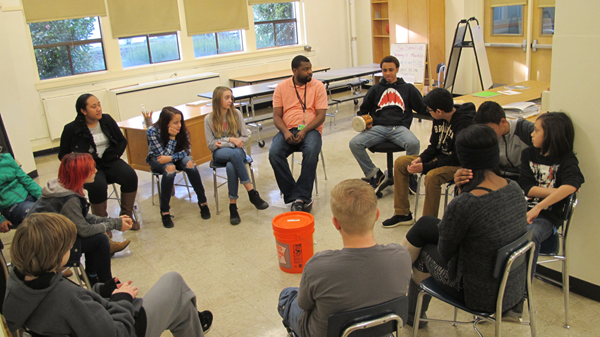4.4 Conducting a Circle
 A typical restorative circle session can run from 25-45 minutes, beginning with bringing everyone together and stating the purpose of the circle. This helps students to understand the type of circle (community-building or responsive) that will be conducted.
A typical restorative circle session can run from 25-45 minutes, beginning with bringing everyone together and stating the purpose of the circle. This helps students to understand the type of circle (community-building or responsive) that will be conducted.
STEP 1 – Starting the Circle
- State the Purpose of the Circle – Inform or remind students of the purpose of circles and the type of circle that will be conducted.
- Open the Circle – Establish a routine/ritual you do to start each circle. This commemorates the transition from regular class to circle time, e.g., place items in the middle of circle for students to focus on.
- Teach or Remember Circle Guidelines – Teach or remind students about guidelines you established, e.g., being open, using the talking stick, respecting others, listening, etc.
- Make or Remind about Agreements – Classroom agreements the students established together using consensus. “What needs to happen in the circle/class for all of us to do our very best?”
STEP 2 – Doing the Work of the Circle
- Connection: Check-in Round with Talking Piece – Invite all students to respond to a low-risk prompt. This gives all students an opportunity to speak and feel connected. Students can suggest check-in questions.
- Core Activities – When discussing challenging behavior, clearly name the issue that will be discussed. It is more meaningful when the topic/issue comes from students.
- Community Building/Connection
- Restorative Practices Content or Deeper Connection
STEP 3 – Ending the Circle
- Closure: Check-out Round – Ask students to comment on their experience in the circle, e.g., “Using a two-word response, tell us about your experience.”
Facilitating restorative dialogue requires engagement. Once the circle has been opened, use the following checklist as a script for facilitating dialogue:
Engagement
- Do we need to talk about what just happened?
- Can you tell me what happened?
Reflection
- What happened?
- Who else was there/around when it happened?
- What were you thinking at the time?
- What have you thought about since?
- Who has been affected/upset/harmed by your actions?
- How do you think they have been affected?
Understanding the harm/impact
- What was your reaction at the time of the incident?
- How did it make you feel?
- What did you think at the time of the incident?
- What have you thought about since?
- How has it upset/hurt/harmed you?
- What has been the worst or hardest thing for you?
- What is needed to make it right/to make you feel better?
- What did you think when that happened?
Acknowledgment
- What do you think now about what you did? Was it helpful?
- What could you say right now to help fix things?
Agreement
- What would you like to see happen to repair the harm?
- Is that fair/do you agree? Could you do that?
- What else needs to happen to make things right?
Arranging Follow-Up
- Let’s make a note of our agreement and I will follow-up with you in the next few days to see how the agreement is going.
Assignment:
